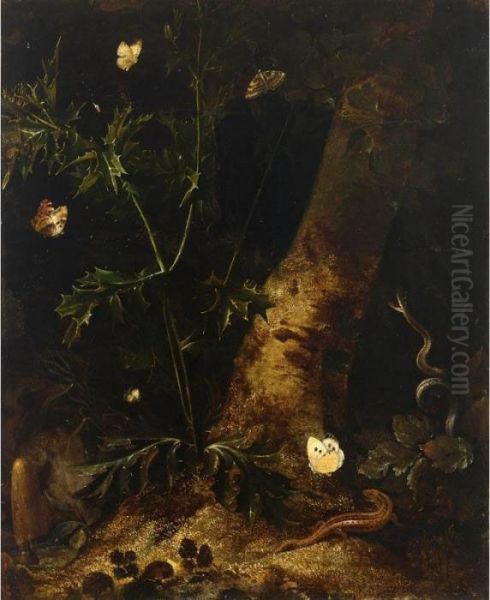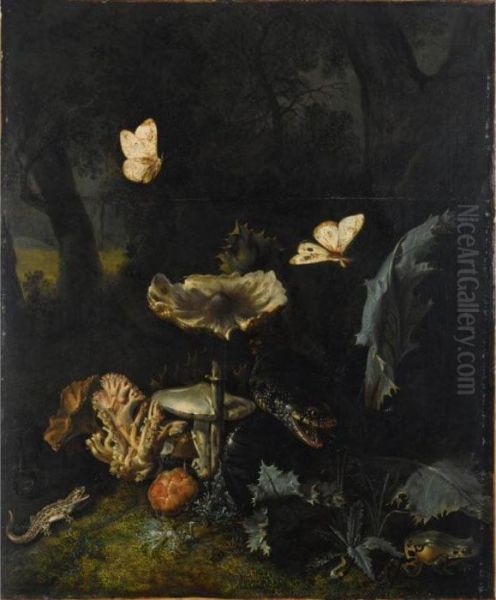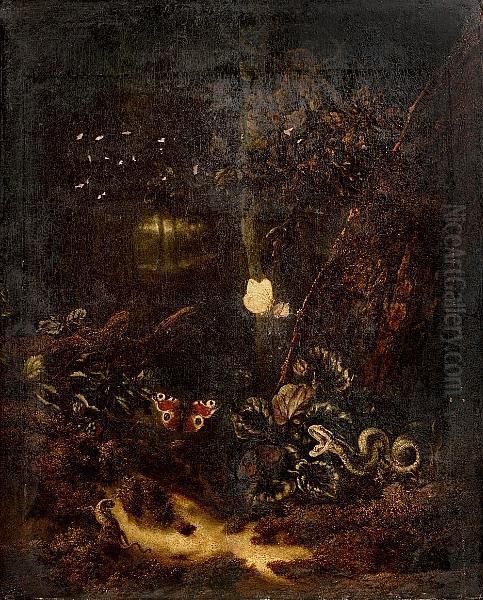The Dutch Golden Age, spanning roughly the 17th century, was a period of extraordinary artistic efflorescence in the Netherlands. Amidst the renowned masters of portraiture, landscape, and genre scenes, a unique and fascinating figure emerged: Otto Marseus van Schrieck. A painter of still lifes, van Schrieck carved out a highly specialized niche, becoming the foremost exponent of the "sottobosco" or forest floor still life. His meticulous, often eerie, depictions of the dark, humid undergrowth, teeming with insects, reptiles, amphibians, and fungi, offer a captivating glimpse into a world both real and imagined, reflecting the era's burgeoning interest in natural science and its enduring fascination with symbolism.
Early Life and Artistic Beginnings
Otto Marseus van Schrieck was born in Nijmegen, a city in the province of Gelderland, Netherlands, around 1619 or 1620. Details about his early training are scarce, a commonality for many artists of this period. However, it is presumed he received a solid grounding in the fundamentals of drawing and painting, likely apprenticing with a local master. The artistic environment in the Netherlands was vibrant, with a strong tradition of realism and an increasing demand for various types of paintings from a prosperous merchant class.
By the late 1640s, van Schrieck had embarked on a journey that would significantly shape his artistic vision: the Grand Tour. This educational rite of passage for many young Northern European artists and aristocrats often included extended stays in Italy, the cradle of the Renaissance and a hub of classical and contemporary art. Van Schrieck was no exception, and his time in Italy, particularly in Rome and Florence, proved pivotal.
The Italian Sojourn: Rome, Florence, and the Bentvueghels
Around 1648-1650, Otto Marseus van Schrieck arrived in Rome. The city was a magnet for artists from across Europe, and the Dutch and Flemish community was particularly active. He became associated with the "Bentvueghels" (Dutch for "birds of a feather"), a society of mostly Dutch and Flemish artists in Rome known for their bohemian lifestyle and initiation rituals. Within this group, artists often adopted a "bent" nickname; van Schrieck's was "Snuffelaar," meaning "the Sniffer" or "the Rummager."

This peculiar nickname was reportedly earned due to his intense, almost obsessive, interest in observing and collecting the small creatures of the forest floor – snakes, lizards, insects, and amphibians – which he would later feature so prominently in his paintings. It is said he even kept a vivarium, a sort of terrarium, to study these creatures up close.
During his Italian period, which lasted until about 1657, van Schrieck formed important artistic relationships. He worked closely with fellow Dutch painters Matthias Withoos and Willem van Aelst. Van Aelst, known for his elegant flower still lifes and hunting pieces, became a particularly close associate and friend. Their styles, while distinct, shared a commitment to meticulous detail and refined execution. Withoos, like van Schrieck, also developed an interest in sottobosco scenes, though often with more expansive, ruin-strewn landscapes.
Van Schrieck's unique subject matter and skillful execution attracted the attention of influential patrons. He worked for Grand Duke Ferdinand II de' Medici in Florence, a testament to the appeal of his unusual compositions even within the sophisticated Italian art scene. The Medici were renowned collectors and patrons of the arts and sciences, and van Schrieck's work, straddling both domains, would have resonated with their interests.
The Development of Sottobosco: A New Genre
It was during his time in Italy, and subsequently upon his return to the Netherlands, that Otto Marseus van Schrieck truly pioneered and popularized the "sottobosco" (Italian for "undergrowth" or "forest floor") still life. This subgenre focused on the dark, damp, and often overlooked corners of nature: the base of trees, shadowy clearings, and the rich humus of the forest floor.
His paintings are typically characterized by a low viewpoint, drawing the viewer directly into this miniature world. The lighting is often dramatic, with shafts of light piercing the gloom to illuminate specific elements, creating a sense of mystery and intrigue. The subjects are the denizens of this realm: intricately detailed fungi of various species, mosses, thistles, poppies, and other wild plants, often intertwined with snakes, lizards, frogs, toads, snails, butterflies, moths, spiders, and beetles.

Van Schrieck's approach was one of intense naturalism. He rendered each element with painstaking precision, capturing the textures of scales, the iridescence of insect wings, the velvety surface of moss, and the delicate gills of mushrooms. There are accounts that he sometimes used a technique called "impasto," applying thick layers of paint, and even incorporated actual butterfly wings or pressed plants onto the canvas to achieve a heightened sense of realism, a practice known as "appliqué." While the latter is debated and difficult to confirm definitively in all cases, the pursuit of verisimilitude was paramount.
Return to Amsterdam and Continued Success
Around 1657, Otto Marseus van Schrieck returned to the Netherlands and settled in Amsterdam. He married Margriet Gysels (or Gijsel) in 1664, the sister of the painter Frans Gysels. Amsterdam was then one of the wealthiest and most dynamic cities in the world, with a thriving art market. Van Schrieck continued to specialize in his sottobosco scenes, which found a ready audience.
He established a property just outside Amsterdam, in Waterrijk (near Diemen), where he could cultivate a garden and reportedly keep his collection of small animals for study. This dedication to direct observation was crucial to the convincing naturalism of his work. His reputation grew, and his paintings were sought after by collectors. Cosimo III de' Medici, Grand Duke of Tuscany, who visited Amsterdam on several occasions, was a notable patron, purchasing several of van Schrieck's works directly from the artist at considerable prices.
His studio likely attracted pupils and followers who were drawn to his unique specialization. While direct pupilage records are not always clear, artists like Elias van den Broeck and, to some extent, Rachel Ruysch show the influence of his sottobosco compositions in their own detailed depictions of forest floor elements, insects, and reptiles, often integrated into more traditional flower still lifes. Ruysch, one of the most celebrated female painters of the Dutch Golden Age, was particularly renowned for her dynamic compositions and scientific accuracy in depicting flora and fauna, an approach that shares common ground with van Schrieck's meticulousness. Her father, Frederik Ruysch, was a famous botanist and anatomist, and this scientific environment likely fostered her appreciation for detailed natural observation.
Themes and Symbolism in the Undergrowth
While van Schrieck's paintings are remarkable for their naturalistic detail, they are also imbued with symbolic meaning, characteristic of much Dutch Golden Age still life. The forest floor, a site of growth, decay, and hidden life, was a potent source of allegory.

Snakes, frequently depicted, were complex symbols. They could represent evil, temptation (as in the Garden of Eden), or death, but also renewal (due to the shedding of their skin) or even wisdom and healing (as in the Rod of Asclepius). Lizards, often shown basking in a patch of light, could symbolize resurrection or the soul's longing for salvation, as they were believed to seek the sun.
Butterflies and moths were common symbols of the soul, transformation, and resurrection, due to their metamorphosis from caterpillar to winged insect. The transience of life was often suggested by the presence of decaying leaves, fungi (which spring up and perish quickly), and the predatory interactions between creatures – a snake attacking a lizard, or a spider ensnaring an insect. These scenes served as a "vanitas," a reminder of the fleeting nature of earthly existence and the inevitability of death.
Thistles and thorns, often prominently featured, could symbolize Christ's Passion, earthly sorrow, or sin. Conversely, a brightly colored poppy might allude to sleep, death (due to its opiate properties), or ignorance. The interplay of light and shadow in his works further enhanced these symbolic readings, with light often representing divine presence or enlightenment amidst the darkness of the earthly realm.
The very act of depicting these humble, often overlooked, creatures and plants could also be seen as a celebration of God's creation in all its diversity, reflecting a growing scientific curiosity that sought to understand and catalogue the natural world. Van Schrieck's work existed at an interesting intersection of art, science, and theology. He was a contemporary of early naturalists like Jan Swammerdam, a pioneering entomologist who used the microscope to study insects, and their shared interest in the minute details of nature reflects a broader cultural shift.
Notable Works: A Closer Look
Several key works exemplify Otto Marseus van Schrieck's distinctive style and thematic concerns:
_Forest Floor with Mushrooms, Snakes, Toads, and Lizards_ (c. 1662): This painting, now in the Staatliches Museum Schwerin, is a quintessential sottobosco. A dark, mossy ground is punctuated by various fungi, a coiled snake, a toad, and lizards. The meticulous detail in the rendering of textures – the slimy skin of the toad, the patterned scales of the snake, the delicate gills of the mushrooms – is remarkable. The scene is alive with a quiet, almost sinister, energy.
_Still Life with Thistle, Snake, and Butterfly_ (c. 1663): Often found in collections like the Mauritshuis, The Hague (though specific locations vary for similar compositions), this type of painting typically features a prominent thistle, a symbol of adversity or the Passion. A snake, perhaps representing evil, might be seen approaching a butterfly, symbolizing the vulnerable soul. The tension between these elements creates a subtle narrative.
_Plants and Insects_ (c. 1665): A title given to many of his works, these paintings showcase his ability to create complex ecosystems on canvas. For example, a piece in the Fitzwilliam Museum, Cambridge, shows a poppy, thistle, and other plants surrounded by butterflies, a snail, a lizard, and a snake, all rendered with his characteristic precision against a dark background.
_Serpents and Insects near a Poppy and a Thistle_ (1670): This work, in the Herzog Anton Ulrich Museum, Braunschweig, is another classic example. The vibrant red of the poppy contrasts with the muted tones of the undergrowth and the sinister forms of the serpents. The composition is carefully balanced, drawing the eye through the various elements of this miniature drama.
His oeuvre, while focused, shows variation in composition and the specific combination of flora and fauna. Each painting invites close inspection, revealing new details and interactions upon sustained viewing.
Artistic Circle and Influence
Otto Marseus van Schrieck was not an isolated figure. His interactions with Willem van Aelst and Matthias Withoos in Italy were formative. Van Aelst, known for his luxurious still lifes, shared van Schrieck's commitment to refined technique, though their subject matter diverged after their Italian period. Withoos, however, continued to paint sottobosco scenes, often incorporating them into larger landscapes with ruins, and his work shows a clear dialogue with van Schrieck's.
The influence of van Schrieck's sottobosco style extended to other artists. Paolo Porpora, an Italian painter active in Naples and Rome, also painted similar forest floor scenes, and it's likely there was mutual awareness, if not direct influence, given their contemporaneous activity in Italy.
In the Netherlands, besides Elias van den Broeck and Rachel Ruysch, other still life painters occasionally incorporated elements reminiscent of his style. The broader context of Dutch still life painting included masters like Jan Davidsz. de Heem, known for his opulent "pronkstilleven" (showy still lifes), and Willem Kalf, whose sumptuous compositions often featured exotic fruits and precious objects. While their focus was different, the underlying Dutch preoccupation with meticulous realism and symbolic meaning connected them all. Early pioneers of detailed floral and insect painting, such as Ambrosius Bosschaert the Elder and Balthasar van der Ast, had laid the groundwork for the close observation of nature that van Schrieck took in a new direction. Even animal painters like Melchior d'Hondecoeter, famous for his depictions of exotic birds in park-like settings, shared an interest in capturing the liveliness and specific characteristics of animal subjects, albeit on a grander scale.
Van Schrieck's specialization was so distinct that he essentially defined the sottobosco genre. His ability to make the dark and often repellent aspects of nature compelling and aesthetically pleasing was unique.
Later Years, Death, and Legacy
Otto Marseus van Schrieck continued to paint in Amsterdam until his death. He was buried in the Oosterkerk in Amsterdam on June 22, 1678. His wife, Margriet Gysels, survived him.
His legacy is that of a highly original artist who carved out a unique niche within the rich tapestry of Dutch Golden Age painting. He was a master of meticulous detail, a keen observer of the natural world, and an artist capable of imbuing his scenes with profound symbolic meaning. His sottobosco paintings offer a window into the 17th-century fascination with the hidden corners of nature, the interplay of life and death, and the intricate beauty of creatures often overlooked.
While perhaps not as widely known today as some of his contemporaries like Rembrandt or Vermeer, Otto Marseus van Schrieck holds an important place in art history. He demonstrated that even the humblest subjects, when rendered with skill and insight, could become compelling works of art. His paintings continue to fascinate viewers with their blend of scientific accuracy, artistic virtuosity, and enigmatic symbolism, securing his reputation as the "Sniffer" who masterfully brought the secrets of the forest floor to light. His influence can be seen in the continued tradition of detailed nature painting and in the appreciation for artists who find beauty and meaning in the less conventional aspects of the natural world.